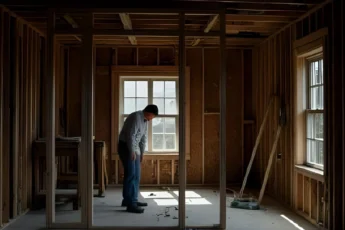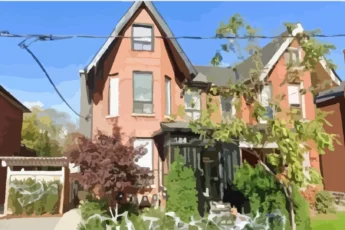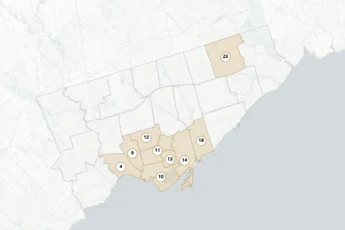Understanding RentSafeTO and Compliance Challenges
In Toronto, landlords of multi-unit residential buildings must comply with the RentSafeTO program. This is a municipal bylaw aimed at ensuring rental properties meet health, safety, and maintenance standards. Properties that fail to meet these standards risk fines, mandatory repairs, and reputational damage.
One Toronto property owner recently faced a compliance setback when their 20-unit complex failed a RentSafeTO audit. This was due to staircase violations. This case highlights a broader issue. Many older rental buildings in Toronto do not meet updated safety codes, making proactive maintenance and compliance planning essential for property owners.
The Issue: Non-Compliant Staircases
The affected property consisted of three multi-unit buildings with a total of 12 staircases. There were six at the front and six at the back. The audit revealed that the stair heights did not meet the Ontario Building Code (OBC) standards. This posed potential safety risks.
Stair height regulations are critical for tenant safety. Improperly measured steps can increase the risk of falls and injuries. According to the Ontario Ministry of Municipal Affairs and Housing, stair risers must generally be between 125 mm and 200 mm (4.92 inches to 7.87 inches) in height. Additionally, tread depth should be at least 255 mm (10 inches).
Failure to comply with these regulations can result in fines of up to $100,000 per violation, as per the Toronto Municipal Code, Chapter 354.
The Solution: Addressing Compliance Through Strategic Renovation
To bring the property up to standard, the owner partnered with LandLord. This is a full-service property management company with an in-house renovations division. The team implemented a structured approach to resolve the issue efficiently.
The first step was a detailed compliance assessment. The team conducted precise measurements of all staircases and compared them against OBC and RentSafeTO standards. This allowed them to identify the specific height adjustments needed to meet regulations.
Next, the team developed a custom design and engineering plan, ensuring that all stair modifications would comply with the latest safety standards. The design process prioritized durable materials to minimize long-term maintenance costs while maintaining the property’s aesthetics.
During the renovation phase, workers adjusted staircase heights across all buildings, making modifications of up to 2.5 inches where necessary. New stair treads and risers were installed to meet modern safety requirements. The renovations were completed over a four-week period, minimizing disruption to tenants.
Throughout the project, quality assurance inspections were conducted. This confirmed compliance with all regulatory requirements before the follow-up audit. Additionally, clear communication was maintained with residents, ensuring they were aware of construction timelines. It also ensured they knew of any temporary safety measures in place.
You Might Also Like: Toronto’s Renovictions Bylaw
Financial Impact and Long-Term Benefits
Investing in compliance renovations allowed the property owner to avoid significant penalties. It also contributed to long-term property value appreciation. Compliance with RentSafeTO ensures that buildings remain habitable and attractive to tenants. This reduces vacancy rates and protects rental income.
Beyond avoiding fines, these types of upgrades can also improve a property’s Net Operating Income (NOI) by reducing long-term maintenance costs and increasing tenant retention. Additionally, in a competitive rental market, well-maintained properties with modernized safety features can justify higher rental rates.
What This Means for Property Owners
This case highlights several key lessons for landlords and investors navigating RentSafeTO audits:
- Regular Property Assessments Are Essential
Conducting annual compliance checks can help landlords identify potential issues before they lead to audit failures. Hiring professionals for periodic inspections can prevent costly surprises. - Understanding RentSafeTO’s Impact on Property Value
Buildings that fail audits risk devaluation, as unresolved violations can lead to fines and potential restrictions on rental increases. Proactive compliance ensures stability in property valuation and tenant demand. - Proactive Renovations Save Money
Addressing non-compliance issues before an audit can prevent unexpected financial strain. Small renovations now can prevent more extensive and costly repairs in the future. - Integrated Property Management and Renovation Services Improve Efficiency
Landlords working with firms that handle both property management and construction can reduce costs and streamline compliance processes, ensuring a faster and more efficient resolution to audit failures.
Final Thoughts
Compliance with RentSafeTO is essential for owners of multi-residential buildings in Toronto.
Addressing maintenance issues before they become violations helps landlords avoid fines, improve tenant safety, and maintain property value. Proactive renovations, regular inspections, and a clear understanding of building code requirements can prevent costly legal and financial setbacks. By staying ahead of regulatory changes and prioritizing property upkeep, landlords can ensure their rental units remain safe, compliant, and attractive to tenants.
Need help? We’re here — contact us to learn how we can help ensure your multi-unit building is compliant.



